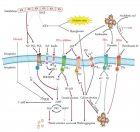Abstract
Research Article
A study on the determination of sex using lip print patterns among indigenes of Akwa Ibom State, Nigeria
Obosi NJ*, Akpantah AO, Archibong VB and Duru GO
Published: 28 January, 2022 | Volume 6 - Issue 1 | Pages: 017-023
The lip print pattern is the characteristic pattern of the wrinkles and grooves present on the labial mucosa. This study evaluated the determination of sex among indigenes of Akwa Ibom State, Nigeria using lip print patterns. 100 subjects (50 males and 50 females), aged 18-25 years participated in the study. With written consent, lip prints were collected from the subjects. Samples were analyzed using Suzuki and Tsuchihashi classification of lip prints. The lip samples were analyzed as a whole and then divided into six portions Right Upper Portions, Middle Upper Portion, Left Upper Portion, Right Lower Portion, Middle Lower Portion and Left Lower Portion and analyzed differently. Data were analyzed using the Chi-square test and T - test analysis. The result shows that the most prevalent lip print in males considering the lip as a whole is Type I (29%) while that of the females is Type I’ (32%). In six portions, there was a significant difference (p < 0.05) between the lip print patterns in male and female subjects in the Right Upper Portion (25.960), Left Upper Portion (15.455) and Middle Left Portion (19.948) suggesting that these portions can be effectively used for sex determination among these indigenes. There was no significant difference (p > 0.05) between the thickness of lip in males and in females but, the lower lip was significantly thicker (p < 0.01) than the upper lip in both gender. Results also showed that the length of lips in males was significantly longer (p < 0.01) than that of females. This study, therefore, concludes that determination of sex among indigenes of Akwa Ibom State using lip length and lip print patterns in specific portions of Right Upper Portion, Left Upper Portion and Middle Left Portion can be effectively done.
Read Full Article HTML DOI: 10.29328/journal.jfsr.1001032 Cite this Article Read Full Article PDF
Keywords:
Lip length; Subjects; Lip samples
References
- Sharma V, Ingle N, Kaur N, Yadav P. Identification of sex using lip prints: A clinical study. J Int Soc Prev Community Dent. 2014; 50: 173-177. PubMed: https://pubmed.ncbi.nlm.nih.gov/25625075/
- Bharathi S, Thenmozhi M. Cheiloscopy - Lip print: A determination of sex and individual. J Pharmaceuti Sci Res. 2015; 1: 113-119.
- Singh J, Gupta K, Sardana V, Balappanavar A, Malhotra G. Sex determination using cheiloscopy and mandibular canine index as a tool in forensic dentistry. J Forensic Den Sci. 2012; 4: 70-112. PubMed: https://pubmed.ncbi.nlm.nih.gov/23741145/
- Satyanarayana NK, Ajay PR. Forensic odontology cheiloscopy. Hong Kong Dent J. 2011; 91: 25-28.
- Tsuchichashi Y. Studies on personal identification by means of lip prints. Forensic Sci. 1974; 3: 233-248. https://pubmed.ncbi.nlm.nih.gov/4858319/
- Suzuki K, Tsuchihashi Y. New attempt of personal identification by means of lip print. J Indian Dent Assoc. 1970; 4: 8-9. PubMed: https://pubmed.ncbi.nlm.nih.gov/5269498/
- Akwa Ibom State. Land of Promise. 2016. https://www.cometonigeria.com
- Sivapathasundharam B, Ajay P, Sivakumar G. Lip prints (Cheiloscopy). Indian J Dent Res. 2001; 12: 234-457. PubMed: https://pubmed.ncbi.nlm.nih.gov/11987663/
- Vijay K, Pravir B, Naveen R. Efficacy of cheiloscopy in determination of sex among South Indians. J Clin Diagnostic Res. 2013; 7: 2193-219. PubMed: https://pubmed.ncbi.nlm.nih.gov/24298473/
- Amith H, Anil V, Nagesh L. Lip prints - Can it add in individual identification. J Oral Health Commun Dentis. 2011; 5: 113-118.
- Kapoor N, Tiwari P. Study of lip prints among the population of Marathi Community. Int J Sci Res Publication. 2013; 45: 1-8.
- Sharma R, Sharma K, Preethi N, Degra H, Rajmani H. Cheiloscopy: A study of morphological patterns of lip prints in Rajasthani population. J Res Med Dent Sci. 2015; 3: 35-38.
- Vats Y, Dhall J, Kapoor A. Gender variation in morphology patterns of lip prints among some North Indian population. J Forensic Dent Sci. 2012; 4: 19-23. PubMed: https://www.ncbi.nlm.nih.gov/pmc/articles/PMC3470412/
- Augustine J, Barpande S, Tupkari J. Cheiloscopy as an adjunct to forensic identification: A study of 600 individuals. J Forensic Odontostomatol. 2008; 27: 44-52. PubMed: https://pubmed.ncbi.nlm.nih.gov/22717789/
- Sandhu S, Bansal H, Monga P, Bhandari R. Study of lip print pattern in a Punjabi Population. J Forensic Dent Sci. 2012; 4: 24-28. PubMed: https://pubmed.ncbi.nlm.nih.gov/23087578/
- Dongarwar G, Bhowate R, Degwekar S. Cheiloscopy - Method of person identification and sex determination. Sci Rep. 2013; 612: 10.4172.
- Vahanwalla S, Nayak C, Pagare S. Study of lip prints as an aid to sex determination. Medico-legal update. 2005; 5: 93-98.
- Malik R, Goel S. Cheiloscopy – A deterministic aid for forensic sex determination. J Indian Academy Oral Med Radiol. 2011; 23: 17-19.
- Why do Africans have large noses and lips? 2009. https://forum.biologyonline.com/topic/why-do-africans-have-large-noses-and-lips
- Bozdag Z, Kurkcuoglu A, Ustdal A, Cam Y, Ozkan O. Upper and lower lip soft tissue thicknesses differ in relation to age and sex. Int J Morphol. 2017; 35: 852-858.
- Emenike NV, Garba SH, Dalori BM, Numan AI. Anthropometric Study of Lip-Nose Complex in adult Igbo’s resident in Maiduguri. J Dental Med Sci. 2012; 1: 29-31.
- Sabri R. The eight components of a balanced smile. J Clin Orthod. 2005; 34: 155-157. PubMed: https://pubmed.ncbi.nlm.nih.gov/15888949/
Figures:
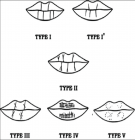
Figure 1
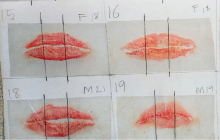
Figure 2
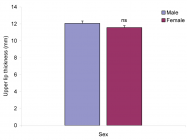
Figure 3
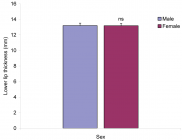
Figure 4
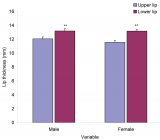
Figure 5
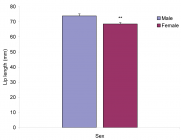
Figure 6
Similar Articles
-
Associations of Burnout, Secondary Traumatic Stress and Individual Differences among Correctional Psychologists`Irina G. Malkina-Pykh*. Associations of Burnout, Secondary Traumatic Stress and Individual Differences among Correctional Psychologists`. . 2017 doi: 10.29328/journal.jfsr.1001003; 1: 018-034
-
The Effect of Cement and wrapping on the Decomposition rate of the Rabbit CarcassesLai Poh Soon*,Khoo Lay See,Nazni Wasi Ahmad,Azlina Zulkapli,Nurul Kharmila Abdullah,Mohd Shah Mahmood,Ahmad Hafizam Hasmi. The Effect of Cement and wrapping on the Decomposition rate of the Rabbit Carcasses. . 2017 doi: 10.29328/journal.jfsr.1001006; 1: 046-062
-
Victim of violent death: what is the role of alcoholemia?Ivan Dieb Miziara*,Carmen Silvia Molleis Galego Miziara. Victim of violent death: what is the role of alcoholemia?. . 2021 doi: 10.29328/journal.jfsr.1001027; 5: 048-052
-
Genetic identification of three exhumed human remains at a hospital in Ghana: a forensic case reportKofi Adjapong Afrifah*,Alexander Badu-Boateng,Samuel Antwi-Akomeah,Eva Emefa Motey,Emmanuel Boampong,David Agyemang Adjem,Osei Owusu-Afriyie,Augustine Donkor. Genetic identification of three exhumed human remains at a hospital in Ghana: a forensic case report. . 2022 doi: 10.29328/journal.jfsr.1001030; 6: 006-011
-
A study on the determination of sex using lip print patterns among indigenes of Akwa Ibom State, NigeriaObosi NJ*,Akpantah AO,Archibong VB,Duru GO. A study on the determination of sex using lip print patterns among indigenes of Akwa Ibom State, Nigeria. . 2022 doi: 10.29328/journal.jfsr.1001032; 6: 017-023
Recently Viewed
-
Prediction of neonatal and maternal index based on development and population indicators: a global ecological studySedigheh Abdollahpour,Hamid Heidarian Miri,Talat Khadivzadeh*. Prediction of neonatal and maternal index based on development and population indicators: a global ecological study. Clin J Obstet Gynecol. 2021: doi: 10.29328/journal.cjog.1001096; 4: 101-105
-
A Genetic study in assisted reproduction and the risk of congenital anomaliesKaparelioti Chrysoula,Koniari Eleni*,Efthymiou Vasiliki,Loutradis Dimitrios,Chrousos George,Fryssira Eleni. A Genetic study in assisted reproduction and the risk of congenital anomalies. Clin J Obstet Gynecol. 2021: doi: 10.29328/journal.cjog.1001095; 4: 096-100
-
Leiomyosarcoma in pregnancy: Incidental finding during routine caesarean sectionToon Wen Tang*,Phoon Wai Leng Jessie. Leiomyosarcoma in pregnancy: Incidental finding during routine caesarean section. Clin J Obstet Gynecol. 2021: doi: 10.29328/journal.cjog.1001094; 4: 092-095
-
Adult Neurogenesis: A Review of Current Perspectives and Implications for Neuroscience ResearchAlex, Gideon S*,Olanrewaju Oluwaseun Oke,Joy Wilberforce Ekokojde,Tolulope Judah Gbayisomore,Martina C. Anene-Ogbe,Farounbi Glory,Joshua Ayodele Yusuf. Adult Neurogenesis: A Review of Current Perspectives and Implications for Neuroscience Research. J Neurosci Neurol Disord. 2024: doi: 10.29328/journal.jnnd.1001102; 8: 106-114
-
Late discover of a traumatic cardiac injury: Case reportBenlafqih C,Bouhdadi H*,Bakkali A,Rhissassi J,Sayah R,Laaroussi M. Late discover of a traumatic cardiac injury: Case report. J Cardiol Cardiovasc Med. 2019: doi: 10.29328/journal.jccm.1001048; 4: 100-102
Most Viewed
-
Evaluation of Biostimulants Based on Recovered Protein Hydrolysates from Animal By-products as Plant Growth EnhancersH Pérez-Aguilar*, M Lacruz-Asaro, F Arán-Ais. Evaluation of Biostimulants Based on Recovered Protein Hydrolysates from Animal By-products as Plant Growth Enhancers. J Plant Sci Phytopathol. 2023 doi: 10.29328/journal.jpsp.1001104; 7: 042-047
-
Sinonasal Myxoma Extending into the Orbit in a 4-Year Old: A Case PresentationJulian A Purrinos*, Ramzi Younis. Sinonasal Myxoma Extending into the Orbit in a 4-Year Old: A Case Presentation. Arch Case Rep. 2024 doi: 10.29328/journal.acr.1001099; 8: 075-077
-
Feasibility study of magnetic sensing for detecting single-neuron action potentialsDenis Tonini,Kai Wu,Renata Saha,Jian-Ping Wang*. Feasibility study of magnetic sensing for detecting single-neuron action potentials. Ann Biomed Sci Eng. 2022 doi: 10.29328/journal.abse.1001018; 6: 019-029
-
Pediatric Dysgerminoma: Unveiling a Rare Ovarian TumorFaten Limaiem*, Khalil Saffar, Ahmed Halouani. Pediatric Dysgerminoma: Unveiling a Rare Ovarian Tumor. Arch Case Rep. 2024 doi: 10.29328/journal.acr.1001087; 8: 010-013
-
Physical activity can change the physiological and psychological circumstances during COVID-19 pandemic: A narrative reviewKhashayar Maroufi*. Physical activity can change the physiological and psychological circumstances during COVID-19 pandemic: A narrative review. J Sports Med Ther. 2021 doi: 10.29328/journal.jsmt.1001051; 6: 001-007

HSPI: We're glad you're here. Please click "create a new Query" if you are a new visitor to our website and need further information from us.
If you are already a member of our network and need to keep track of any developments regarding a question you have already submitted, click "take me to my Query."









